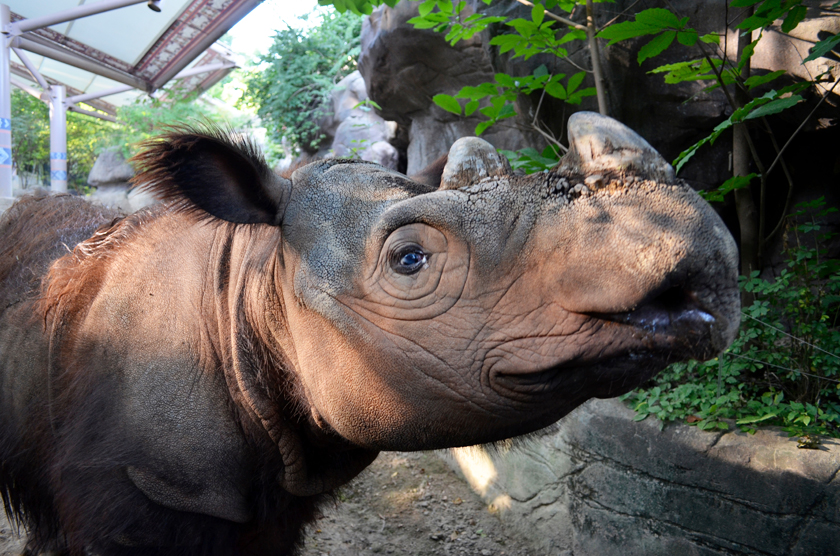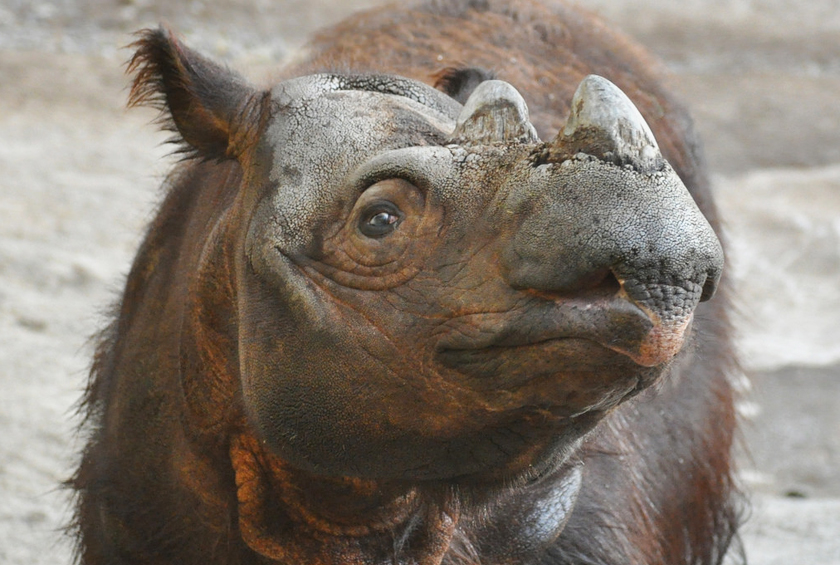Cincinnati Rhino Needed In Sumatra
Ohio zoo sending “Harapan” to Indonesia in hopes he’ll mate and help save his species.
By Vicki Croke
Handsome Harapan should be joining his older brother in a sanctuary in Sumatra this fall. Photo: Cincinnati Zoo.
In order to help save his species, Harapan, the only Sumatran rhino living outside Southeast Asia, is going home—even though he’s a big-city American-raised rhino who’s never even seen “home” before.
Members of the Cincinnati Zoo made it official in a news conference yesterday.
The reproductive potential of the 1,800-pound 8-year-old is desperately needed on the other side of the world. So, sometime this fall, Harapan, the urban zoo rhino, is expected to be sent to the wilds of the Sumatran Rhino Sanctuary (SRS), a breeding facility in the Way Kambas National Park in Indonesia, where three potential mates wait. The young male has a chance to boost the world population of Sumatran rhinos, which today stands at about 100. According to the International Rhino Foundation, this is “the most endangered of all rhinoceros species because of its rapid rate of decline.”
Sumatran rhinos are shaggy and sometimes called the “hairy rhino.” Photo: Cincinnati Zoo.
Just last week, a paper published in Oryx, the International Journal of Conservation, highlighted the precarious status of these critically-endangered rhinos and called for all members of the species to be viewed as a single population without regard to borders. There are nine rhinos in captivity—Harapan in the US, three in Malaysia, and five in the sanctuary where Harapan is heading. Conservationists believe that there are no Sumatran rhinos living in the wild in Malaysia any longer, and that the only free rhinos left in the world are found on the Indonesian island of Sumatra. Even there, the population is fragmented and often isolated from one another. Enough so that experts worry they cannot even find one another to mate.
Vicki spoke with Here&Now’s Robin Young about Harapan and the future of Sumatran rhinos:
In a telephone interview, Dr. Terri Roth, Director of the Zoo’s Center for Conservation & Research of Endangered Wildlife (CREW) said she felt attached to Harapan, and would be personally sorry to see him leave, but that she was taking the long view on the issue. “We’re sad about the [Cincinnati Zoo’s Sumatran rhino breeding] program ending,” Roth said, “but we are absolutely proud of the role we’ve played in the program.” In a statement to reporters, she added, “We need to focus on all we have accomplished, for there is much to celebrate. The Cincinnati Zoo has had a profound, historic impact on the effort to save this species.”
Keeper Paul Reinhart, shown with Harapan, will be escorting the rhino to Sumatra. Photo: Cincinnati Zoo.
In fact, they’ve been pioneers. Among other things, Roth and her team were able to decode many of the mysteries of Sumatran rhino reproduction. Learning about their hormones levels, for instance. Tracking their ovulation through ultrasound. And discovering the fact that these rhinos are “induced ovulators,” meaning females need a male around to even ovulate. Cincinnati is the only US zoo to produce baby Sumatran rhinos.
Female Emi and her mate Ipuh, had three babies at the Cincinnati Zoo—Andalas in 2001, the first calf born in captivity in more than 100 years; Suci, a female in 2004, and then Harapan in 2007. For more than a decade, the Cincinnati Zoo was the only place successfully breeding this endangered species in captivity.
Newborn Harapan in 2007 with his mother Emi. Video courtesy of Cincinnati Zoo.
But Emi and Suci died of hemochromatosis, a disorder that causes a metabolic iron overload. Ipuh died of old age. And Andalas was sent to the sanctuary in Sumatra. That left only Harapan. And, according to Roth, zoo officials understood that Indonesia would not be sending more rhinos here. Just before Suci’s death, the zoo even announced that it planned to breed the siblings to one another in a last ditch effort to increase rhino numbers.
In the wild, numbers have been plummeting too. Habitat loss and poaching for rhino horn have taken their toll. The population of Sumatran rhinos has been reduced by 50 percent in the last 20 years.
The sanctuary where Harapan will be sent is a kind of wild-captivity. Set in a national park, Roth said the enclosures are 20- to 25-acres each. But the animals are safe—the area is fenced and patrolled by the trained members of the Rhino Protection Units. And they are cared for much in the way zoo animals are—with caretakers feeding them and attending to medical needs.
Harapan loves mud—he should be getting plenty of it in the Sumatran rainforest. Video courtesy of Cincinnati Zoo.
Sumatran rhinos have been popular animals to keepers and zoogoers. As Roth said, “It’s hard not to fall in love with them!” I understand why. I got to meet matriarch Emi in the 1990s when she was at the Los Angeles Zoo and I was writing a book about zoo and conservation issues called “The Modern Ark.” Emi was relatively petite (Sumatrans are the smallest of the five living rhino species), shaggy, and gregarious. Her personality was so much like that of a lapdog, and she was known to be so fond of people, that her keeper let me pat her. Clearly she enjoyed the companionship, and leaned in for a rub. When she vocalized, I thought she sounded like a cross between TV chef Julia Child and a whale.
Capturing wild Sumatran rhinos and bringing them into captivity for breeding was controversial then—it was expensive, captives died along the way, and it looked for a long time as though the animals wouldn’t reproduce. Today, there are differences of opinion too about how exactly to save this species.
Sumatran rhinos like Harapan have two horns and a hooked, prehensile upper lip built for grabbing leaves. Photo: Kathy Newton/Cincinnati Zoo.
But Harapan means “hope” in Indonesian. And there is hope. Although he never met his older brother Andalas, that rhino has proven that zoo-born Sumatran rhinos can thrive in the world that is home to their species. Roth said, “As far as we can tell, Andalas was never even sick a day once he went over there.” Andalas is not only healthy, he is fertile and game: he has already fathered one male calf in 2012.
Also on The Wild Life:
Courage Of A Tiny Orphaned Rhino
A Kenyan Community Helps Rhinos Come Home
Baby Rhino Beats The Odds… And The Poachers
For now, the only delay is paperwork. Roth told us yesterday that they do have the import permit from Indonesia. “That’s a big hurdle and we’re glad to have that in hand, but we still need an export permit from the U.S. Fish and Wildlife Service before we can really set a date and get things rolling.” Harapan is being trained now to make the travel less stressful for him. Among other steps, he’s being crate-trained so that he will view his shipping crate as a safe and comfortable place. Then, if all goes as expected, accompanied by familiar humans, like his keeper Paul Reinhart, he will fly by plane to Jakarta, take a ferry to Sumatra, and then be trucked the rest of the way to the sanctuary.
It won’t be Cincinnati, but hopefully the girls will make him feel at home.





One Response to “Cincinnati Rhino Needed In Sumatra”
Send the sperm, not the Rhino.
Comments are closed.